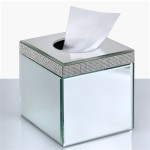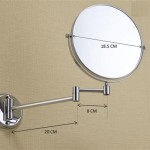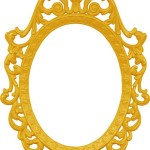The Enduring Allure of Old Wall Mirrors
Old wall mirrors, more than mere reflective surfaces, serve as portals to bygone eras. Their presence in a space transcends functional utility, imbuing rooms with character, history, and a distinct aesthetic appeal. From the opulent grandeur of Baroque designs to the understated elegance of mid-century modern pieces, old wall mirrors offer a tangible connection to the past, allowing owners to incorporate a piece of history into their contemporary living spaces.
The diversity of old wall mirrors stems from a confluence of factors, including the era of their creation, the materials employed, the craftsmanship involved, and the prevailing artistic trends of the time. Understanding these elements provides a deeper appreciation for the value and uniqueness of each mirror, enabling informed decisions when acquiring and preserving these historical objects.
The Historical Context of Old Wall Mirrors
The history of mirrors dates back to ancient civilizations, with early examples crafted from polished metals such as copper, bronze, and silver. These rudimentary mirrors were primarily used for personal grooming and held symbolic significance in religious and ceremonial practices. The advent of glass mirrors, backed with reflective materials like tin amalgam, marked a significant turning point in mirror production, allowing for clearer and more accurate reflections. This technological advancement fueled a surge in popularity of mirrors, transforming them from luxury items reserved for the wealthy elite to more accessible decorative objects.
The design and style of wall mirrors evolved in tandem with changing architectural and artistic trends throughout history. During the Baroque period (roughly 1600-1750), mirrors were often large and ornate, featuring elaborate gilded frames adorned with intricate carvings and scrolls. These mirrors were designed to reflect light and enhance the grandeur of opulent interiors. The Rococo period (roughly 1730-1770) saw the emergence of lighter, more asymmetrical designs, with frames embellished with delicate floral motifs and playful ornamentation. Neoclassical mirrors (roughly 1750-1850) embraced symmetry and clean lines, drawing inspiration from classical Greek and Roman architecture. These mirrors often featured restrained ornamentation and were frequently incorporated into architectural elements such as fireplace mantels and door frames.
The 19th century witnessed a proliferation of mirror styles, reflecting the diverse tastes and technological advancements of the era. Victorian mirrors were often characterized by their elaborate designs, incorporating elements such as floral motifs, geometric patterns, and carved details. The Art Nouveau movement (roughly 1890-1910) introduced organic forms and flowing lines, with mirrors featuring frames adorned with stylized flowers, vines, and figures. The Art Deco period (roughly 1920-1940) embraced geometric shapes, bold colors, and luxurious materials, with mirrors featuring streamlined designs and opulent finishes. Mid-century modern mirrors (roughly 1945-1965) prioritized functionality and simplicity, with clean lines, minimalist frames, and a focus on natural materials such as wood and metal.
Identifying the historical period of an old wall mirror can provide valuable insights into its origins, craftsmanship, and potential value. Examining the style of the frame, the materials used, and any identifying marks or labels can help to narrow down the date of manufacture and authenticate the mirror's provenance. Consulting with antique experts or conducting thorough research can further assist in accurately identifying the historical context of an old wall mirror.
Materials and Craftsmanship
The materials used in the construction of old wall mirrors played a crucial role in their aesthetic appeal and durability. The frames were typically crafted from wood, metal, or a combination of both, with each material offering unique characteristics and advantages. Hardwoods such as oak, mahogany, and walnut were prized for their strength, durability, and beautiful grain patterns, while softwoods such as pine and fir were often used for less expensive mirrors. Metal frames were typically made from brass, bronze, or iron, and were often gilded or finished with decorative coatings. The mirror glass itself was typically made from hand-blown or machine-made glass, with variations in thickness, clarity, and reflective quality.
The craftsmanship involved in creating old wall mirrors was often highly skilled and meticulous. Frames were typically hand-carved, gilded, and assembled, with intricate details and embellishments added by experienced artisans. Mirror glass was carefully cut, polished, and silvered, with precise techniques used to ensure a clear and distortion-free reflection. The assembly of the frame and the mirror glass required a high level of precision and attention to detail, ensuring a seamless and durable finished product.
The quality of the materials and the level of craftsmanship are important indicators of the value and authenticity of an old wall mirror. Mirrors made from high-quality materials, such as hardwoods and precious metals, and crafted with meticulous attention to detail, are generally more valuable and desirable. Examining the construction of the frame, the quality of the mirror glass, and the presence of any original hardware or labels can help to assess the craftsmanship and authenticity of an old wall mirror.
Damage and deterioration over time can affect the integrity and appearance of the materials. Wood frames are susceptible to warping, cracking, and insect infestation, while metal frames can corrode or tarnish. Mirror glass can become scratched, chipped, or discolored due to age and environmental factors. Proper cleaning, preservation, and restoration techniques can help to mitigate damage and preserve the beauty and value of old wall mirrors.
Preservation and Restoration
Preserving and restoring old wall mirrors requires a delicate balance between maintaining their historical integrity and ensuring their continued functionality and aesthetic appeal. Improper cleaning or restoration techniques can inadvertently damage the mirror or detract from its value. It is essential to approach preservation and restoration with caution and to consult with experienced professionals when necessary.
Cleaning an old wall mirror should be done with gentle methods and appropriate cleaning solutions. Dust can be removed with a soft, dry cloth, and fingerprints or smudges can be cleaned with a mild solution of soap and water. Abrasive cleaners or harsh chemicals should be avoided, as they can scratch or damage the mirror glass and the frame. The frame can be cleaned with a soft brush or a damp cloth, taking care to avoid getting water on the mirror glass.
Repairing damage to the frame or the mirror glass can be a complex process that requires specialized skills and knowledge. Wood frames can be repaired by filling cracks, patching missing pieces, and re-gilding or refinishing the surface. Metal frames can be repaired by welding, soldering, or replacing damaged components. Mirror glass can be repaired by patching small chips or cracks, or by replacing the entire mirror panel. When replacing mirror glass, it is important to use glass that is similar in thickness and reflectivity to the original glass.
Restoration should aim to preserve the original appearance and character of the old wall mirror. Avoid stripping away its patina. Repairing damage and stabilize the structure of the frame is the overall goal. Refinishing or re-gilding should be done in a manner that is consistent with the original finish and style.
Storage conditions can play a significant role in the preservation of old wall mirrors. Mirrors should be stored in a dry, climate-controlled environment, away from direct sunlight and extreme temperatures. Mirrors should be protected from dust and moisture, and should be handled with care to avoid scratches or damage.

Antique Mirrors Does Age Matter

Antique Mirrors A Guide To Identifying Collecting

Antique Teakwood Wall Mirror Shape Rectangle

Mirror The Right Way To Use Mirrors In Your Home Antique Wall Glass Distressed

Vintage Mirror Wall For With Hooks Wood Sweden

32 Creative Gallery Wall Ideas To Transform Any Room Mirror Decor

Feature Mirror Walls Creoglass Design

Affordable Custom Antique Mirrors In New York

Vintage Mirror Wall Antique Old Mirrors Gold Singapore

Small Wall Mirror Antique Mirrors








